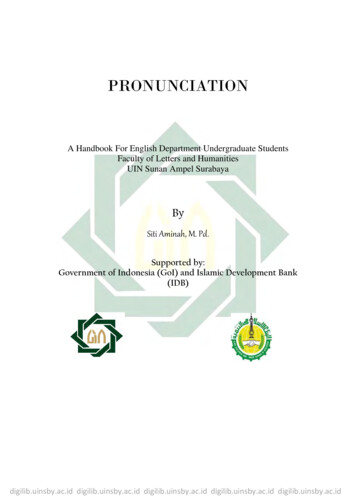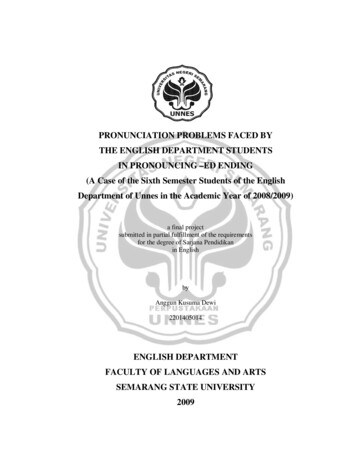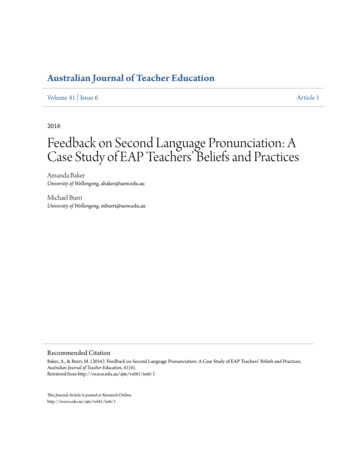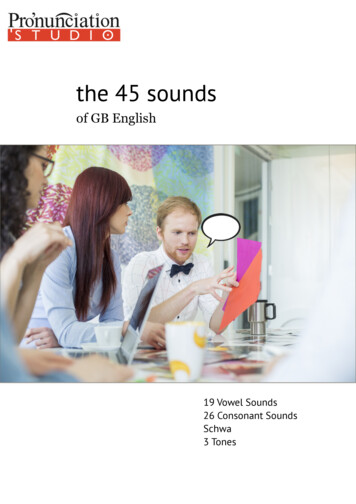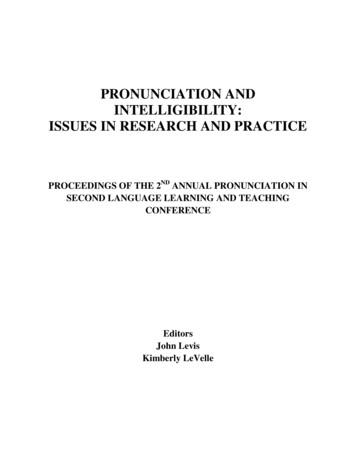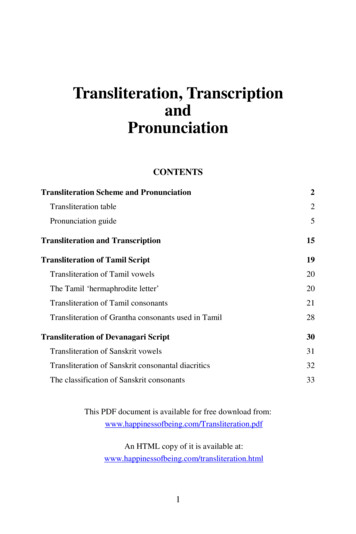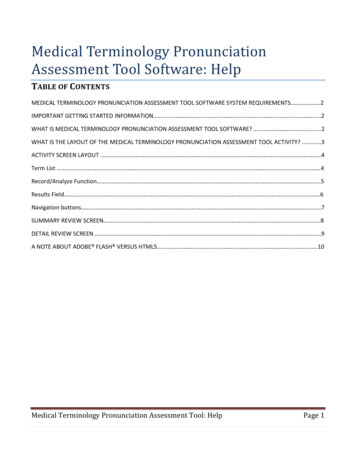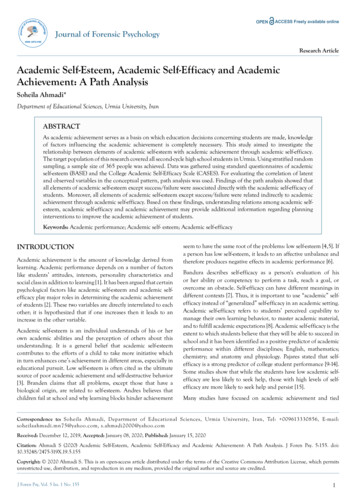
Transcription
Jonathan Smith is a pre-sessional programmedirector in the International Study andLanguage Centre at the University of Reading,where he is responsible for the developmentand management of the programme during theacademic year. His interests include theteaching and testing of listening and speakingskills, sound/spelling relationships and theapplications of technology in languagelearning. He has worked in EFL and EAP for 30years and has taught in Europe, North Africaand the Far East.The eight units are organized as follows: Annette Margolis teaches children of all agesin her adoptive town of Latina, Italy. Sheoriginally trained as a primary science teacherafter completing a chemistry degree atBirmingham University and finds that havingthis science background complements her skillsas an EFL/EAP teacher. Annette is a YL CELTAextension tutor.Each unit explores a key aspect of English pronunciation,for example, the pronunciation of individual sounds,syllables and word stress patterns. The written andlistening texts, which focus on key academic vocabulary,will allow you to practise your pronunciation so that youcan be understood with ease.EAS: Pronunciation includes unit summaries to giveyou a quick overview of what you have covered, and acomprehensive glossary of terms. Each unit also hasweblinks offering additional information and activities,relating to both pronunciation skills and the topics coveredin the units. Visit the dedicated English for Academic Studywebsite at www.englishforacademicstudy.com for evenmore resources.This book can be used in conjunction with the followingbooks in the English for Academic Study (EAS) series,also published by Garnet Education: EAS: Reading,EAS: Writing, EAS: Extended Writing & Research Skills,EAS: Speaking, EAS: Vocabulary and EAS: Listening.Jonathan Smith and Annette MargolisT he International Study and Language Centre(ISLC) at the University of Reading has nearly40 years’ experience in offering English forAcademic Purposes (EAP) courses tointernational students. It has a long-standing,worldwide reputation for the quality of itstuition, materials development and the supportgiven to students during their time in highereducation.Pronunciation Vowel sounds 1, word stress and weak formsVowel sounds 2, word stress patternsConsonant sounds 1, sentence stressConsonant sounds 2, word stress on two-syllablewordsDiphthongs 1, sounds in connected speechConsonant clusters 1, tone units 1Diphthongs 2, tone units 2Consonant clusters 2, intonationNew editionEnglish for Academic Study: Pronunciation Study BookThis fully updated 2012 edition of English for AcademicStudy: Pronunciation will help you develop thepronunciation skills you need to communicate clearly andeffectively in an academic environment.English forAcademic StudyComponents:EAS Pronunciation Study Book with CDsISBN 978 1 90861 435 3Study BookSuitable for:Upper intermediateto proficiencywww.garneteducation.comCEF B2–C2GARNET EDUCATIONIELTS 5.0–7.5 Jonathan Smith and Annette Margolis
Book mapTopics1 Vowel sounds: /œ/, /e/,/I/, /Å /, /‰ /, /i /Syllables and word stressWeak forms in functionwordsObjectives 2 Vowel sounds: /Å/, /ø/, / /, /U/, /O /, /u /Unstressed syllables andword stress patterns 3Voiced and unvoicedconsonantsConsonant sounds: /T/, /D/, /t/, /s/ Sentence stress Consonant sounds: /Z/, 4 /v/, /K/, /S/, /tS /, /dZ/ Word stress on two-syllablewords 5 Diphthongs: /aI/, / U/, /eI/Sounds in connectedspeech: linking, insertion 6 4Consonant clusters: at thebeginning and in the middleof wordsSounds in connectedspeech: disappearingsounds, contractionsTone unitsEnglish for Academic Study Learn which phonemic symbols represent certainvowel soundsPractise recognizing and producing these vowelsoundsLearn about the concepts of the syllable and wordstressPractise producing words with the correct wordstress;Practise recognizing weak forms of function wordswhen listeningLearn which phonemic symbols represent the othervowel soundsPractise recognizing and producing these vowelsoundsLearn more about which syllable is stressed in sometypes of wordLearn about the pronunciation of voiced andunvoiced consonantsPractise recognizing and producing these soundsLearn to identify stressed words in sentencesPractise using sentence stress to highlight importantinformationLearn phonemic symbols representing consonantsoundsPractise recognizing and producing these consonantsoundsLearn where to place the stress in words with twosyllablesLearn which phonemic symbols represent certaindiphthongsPractise recognizing and producing diphthongsLearn how the pronunciation of words is affected bytheir context in connected speechLearn how to pronounce groups of consonants(consonant clusters) at the beginning and in themiddle of wordsLearn how to divide up connected speech into toneunits
Topics78Objectives Diphthongs: /aU/, /e /, Sentence stress and toneunits Consonant clusters: at theend of words and acrosstwo wordsIntonation /I /, /OI/ Learn which phonemic symbols represent otherdiphthongsPractise recognizing and producing these diphthongsHave more practice identifying sentence stress andtone unitsLearn how to pronounce consonant clusters at theend of words and across two wordsLearn how intonation is used to organize andemphasize informationPronunciation5
iIntroductionAims of the course:The purpose of this book is to help you to improve the accuracy of your pronunciation, developyour listening microskills, learn the phonemic alphabet, build your understanding of sound/spelling relationships, recognize and remember words and phrases that commonly occur inacademic contexts.Accuracy of pronunciationAccurate pronunciation is important if you want people to understand you clearly. Frequentpronunciation errors may put a strain on the listener, and may also lead to breakdowns incommunication. While you do not have to speak with a perfect English accent, your aim mustbe at least for your pronunciation to be good enough for the listener to understand you with ease.The main technique you can use to achieve this is to listen and repeat patterns of pronunciation,but learning the phonemic alphabet and developing a sensitive ear will also help you.Learning the phonemic alphabetThe phonemic alphabet is a system for showing the pronunciation of words in English, and isshown on page 9 of this book. At first glance, the phonemic alphabet looks like another languagethat you have to learn. However, about half of the 44 phonetic symbols that you are expectedto know are pronounced in the same way as they are written. We have focused on: those symbols which may be unfamiliar, and so may be difficult to learn those sounds which may be difficult to pronounce for certain learnersWe believe that learning the phonemic alphabet will help you to develop more accuratepronunciation and improve your listening skills. In addition, if you know the phonemic alphabetyou can: understand the correct pronunciation when looking up a word in a dictionary note down the correct pronunciation in your vocabulary notebookSo, knowing the phonemic alphabet is another important aspect of recording and learningvocabulary.Listening microskillsIn listening classes, you will have had practice understanding meaning that is built up over asentence or several sentences, but you may have had difficulty with comprehension at a lower level.Listening microskills are the skills you need to understand meaning at the level of a word or smallgroup of words.Students frequently remark that there are many words that they know in their written form, but failto recognize when listening. There may be several reasons for this; for example, words may not bepronounced in the way you expect them to be, or it may be difficult to hear where one word endsand another begins. Many activities in this book will help you to deal with such problems.6English for Academic Study
IntroductioniSound/spelling relationshipsAnother difficulty faced by students is that there does not seem to be a relationship between theway words are spelt in English and the way they are pronounced. This creates problems, not just foraccurate pronunciation, but also for correct spelling. In fact, while there are exceptions (and manyof these exceptions seem to relate to the most common words in English), there are a lot of usefulsound/spelling patterns. If you can ensure that you are familiar with these patterns, you can thenfocus on learning the exceptions, which are the words that create the most problems.Academic vocabularyThe examples and exercises in these materials are focused on words from: the General Service List (GSL): the 2,000 most frequently used words in English the Academic Word List (AWL): a list of 570 word families that are most commonly used inacademic contextsAll the words in the AWL will be useful to you, but some of the words in the GSL are either wordsyou may know already (e.g., you, from, hand) or words that are not commonly or widely used inacademic contexts (e.g., handkerchief, niece, jealous). In general, words like these have not beenused in the examples and exercises.In addition, a number of extracts from academic lectures have been used to provide practice inlistening for features of pronunciation.A lot of care has been taken, therefore, to ensure that the vocabulary focused on in this book isrelevant to both academic study and your needs. Many words will be those you ‘half know’, so thematerials should reinforce your understanding. Other words may be quite new to you.Structure of the courseThere is a range of different exercises that require you to work in different ways. For example, youmay need to: listen and repeat words or sentences stop the recording and read an explanation stop the recording, write words in spaces in sentences, then listen to check your answers stop the recording, fill in a table or choose the correct answer, then listen to check your answersIf you just play the recording non-stop, listening and reading at the same time, you will not improveyour pronunciation or listening skills. You will have to stop the recording to read, think, write andcheck answers, and you will have to replay short sections you have difficulty with. Pronunciation notesEach unit has at least one Pronunciation note. These notes explain different rules relating to thecontent in that unit, for example, the pronunciation of consonant clusters. Study tipsThese are included for ease of reference when you are revising what you have studied. Theyeither summarize the outcome of a series or activities or are a summary of other informationcontained in the unit.Pronunciation7
Listening materialThis is available on CD and is indicated by the play icon . The full transcripts for the audio materialare available at the back of the book, starting on page 77.Recording your own voiceWhen you are asked to listen and repeat words, phrases or sentences, it can also be very usefulto record your own voice and then play it back. This will enable you to compare your ownpronunciation with the recording, and hear any differences or problems clearly. You will not needto record your voice for every exercise, but try to do this when you know you have a problem withcertain aspects of pronunciation.If you are unsure whether your pronunciation on an exercise is accurate enough, and you areworking with a teacher, ask him or her to listen to your recording. He or she will be able to assessyour pronunciation more objectively.Additional materialsGlossary: Words or phrases in bold (or bold and underlined in the task introductions) in the textare explained in the Glossary on page 75.Answer key: Answers for all the exercises are provided.Transcripts: Starting on page 77, you will find the transcripts of all the audio material. Your teacherwill sometimes give you the opportunity to listen to the recordings and follow the transcript at thesame time, once you have completed the main listening tasks.8English for Academic Study
Consonant sounds 1,sentence stress3In this unit you will: learn about the pronunciation of voiced and unvoiced consonants practise recognizing and producing these sounds learn to identify stressed words in sentences practise using sentence stress to highlight important informationIn Units 1 and 2, you studied vowel sounds. You will now look at consonants, particularlyconsonants that English for Academic Purposes (EAP) students often find hard to pronounce. Youwill also look at how English speakers stress certain words in phrases and sentences.Task 1Voiced and unvoiced consonantsWhen you pronounce a vowel, air passes freely through the mouth. When you pronounce aconsonant, the air stream may be totally or partially obstructed (blocked) by the tongue, teeth or lips.There are a number of pairs of consonants that are pronounced in the same way, except that oneconsonant is unvoiced and the other is voiced.For voiced consonants /b/, /d/,/g/, etc., the vocal chords in yourthroat vibrate.For unvoiced consonants /p/, /t/,/k/, etc., there is no vibration.1.1 CD1: 29 Listen and repeat these continuous consonant sounds and some wordsthat contain them. What is the difference between them?\s\ snow, race\z\ zero, raiseThe position of your tongue, lips and mouth is moreor less the same for each sound, but for the \z\sound there is also a vibration of your vocal chords,so we say that \z\ is a voiced consonant. Thereis no vibration for the \s\ sound, so it is unvoiced.In the table in Ex 1.2, each pair of consonants( \p\ and \b\, \t\ and \d\, etc.) is pronounced in thesame way, except that one is voiced and the other is unvoiced.Pronunciation27
1.2 CD1: 30 Listen and repeat each pair of words from the table. Can you hear thedifference in S\ is unvoiced, e.g., meshFor both these sounds, thetongue is held close to theroof of the mouth. There isa narrow gap through whichyou force air. Compare thesesounds with \s\ and \z\ onpage 27. You will see thetongue is higher and furtherback in the mouth.\z\ is voiced, e.g., measure\f\ is unvoiced, e.g., fastFor both these sounds, theinside part of the bottom lipis held against the top teeth.Pressure is released as youbring the bottom lip awayfrom the top teeth.\v\ is voiced, e.g., vastStudy tip1.3 CD1: 31 Listen to the following words andcircle the one you hear.Each pair is pronounced in the same way except thatone consonant is unvoiced and the other is h for Academic StudyYou can check that you areproducing voiced consonantscorrectly if you put your fingerson your throat as you say them.You should be able to feel yourvocal chords lesymbol7.cardg uardtensedense8.classglass
Consonant sounds 1, sentence adge11.priceprize16.fewview12.use (n)use (v)17.proofprove13.adviceadvise18.beliefbelieve3 CD1: 31 Then listen and repeat the words with the correct voiced or unvoicedconsonant. Pronunciation note It is not always easy to distinguish voiced and unvoiced consonants. This can beparticularly difficult when they are at the ends of words where the voicing of someconsonants may be reduced, e.g., hard/heart.1.4 CD1: 32 Listen and complete these sentences or phrases.1.a. asituationb. amaterial2. a. ab. as3.a. at theb. the4. a. PublicVareaas a sheetof the plantof changehave improved.b. A cube has six5.a. difficult tob. It’s had good6. a. theb. It changed the.of the fireof his life.1.5Write U or V in the boxes provided to show if the missing word has an unvoicedor voiced consonant.1.6 CD1: 32 Listen again and repeat the sentences or phrases, focusing on accuratepronunciation.Pronunciation29
/T/, /t/ and /s/ think, time, sendTask 22.1 CD1: 33 Listen to the difference in pronunciation between these pairs of athdebt CD1: 33 Listen again and repeat the words. Pronunciation note /T/ is always written as th (think, both).2.230 CD1: 34 You will hear some of the words from Ex 2.1. Circle the phonemictranscription that matches the pronunciation of the word you hear.1.\TIn\\tIn\2.\Tœnk\\tœnk\3.\deT\\det\4.\b UT\\b Ut\5.\w‰ T\\w‰ s\6.\pA T\\pA s\7.\maUT\\maUs\8.\Ku T\\Ku s\English for Academic Study
Consonant sounds 1, sentence stress2.3Complete these sentences with words from Ex 2.1.1. 5 million.The painting is supposed to be2. The fuel is stored in a 30-litre3.5.Cancer is the leading cause of4. Aamong women.layer of plastic is needed to provide waterproofing.I couldn’t follow theof his argument.6. The2.43is, no one likes to be criticized.7.Tax increases are necessary to finance the national CD1: 35 Listen to the correct answers and repeat the sentences.Task 3./D/ that/D/ occurs as the first sound in a number of common function words.3.1 CD1: 36 Listen and repeat these heythenthough* These words have the same pronunciation.\D\ also occurs at the end of some common words as \DE\, spelt ** These words have the same pronunciation.3.2 CD1: 37 Listen to these sentences and phrases and repeat them.1.What’s the weather like there?2. Let’s get together.3.I’d rather not.4. I wouldn’t bother.5.I don’t like them.6. I don’t like them, either.7. further down the road 8. the other day Pronunciation31
/T/ and /D/ think, thatTask 4/T/ is unvoiced, e.g., thinFor both these sounds,the tip of the tongue isheld against the backof the teeth. Pressure isreleased as you bring thetip of the tongue awayfrom the teeth./ð/ is voiced, e.g., the4.1 CD1: 38 Listen to these two words.thankthan\TœNk\\Dœn\To pronounce both \T\ and \D\, you put the tip of your tongue between your teeth, but \D\is also voiced. Can you hear how \D\ has a heavier sound than \T\?4.2 CD1: 39 Listen to these phrases and write in the correct symbols above thewords.DT1. another thing to consider is 2. in theory 3. the truth is that 4. the growth rate 5. a further theme 6. they thought that .7. this method 8. beneath the surface 9. this therapy might be used to 10. youth culture CD1: 39 Now listen again and repeat the phrases. Pronunciation note If you find the \T\ sound difficult to pronounce, people should still understand fromthe context if you replace it with the \s\ sound or the \t\ sound.32So, if you can’t say try saying thankthinworthsank, tanksin, tinworseEnglish for Academic Study
Consonant sounds 1, sentence stress3Similarly, if you find the \D\ sound difficult to pronounce, people should stillunderstand from the context if you replace it with the \z\ sound or the \d\ sound.So, if you can’t say try saying theythenbreathedayzen, denbreezeTask 5Sentence stressWhile word stress (or accent) is generally decided by language rules, sentence stress (or prominence)is decided by speaker choice. The speaker usually chooses to stress content words, which carry theinformation, and not structure or function words, such as auxiliary verbs, pronouns, prepositions anddeterminers, although this is not always the case.5.1 CD1: 40 Listen to the paragraph. Notice which words are stressed.So whose responsibility is it to ensure that children eat healthily? Well, clearly parentshave a role, but while children are at school, it’s difficult to keep track of what they areeating, so some would suggest that schools need to encourage healthy eating, andthat this should be reflected in the menus they offer. Then there’s the food industry.They’ve been criticized in the past for high levels of sugar, fat and salt in food and fornot giving clear information on the levels of different ingredients in food. And finallythere’s the government. Should legislation be used to address this issue?5.2 CD1: 41 Listen to these sentences in which the stress changes according to themeaning. Practise repeating them with the correct stress.1.5.3You have to hand in the essay on Monday there’s a strict deadline.2. You have to hand in the essay on Monday not the report.3. not Wednesday.You have to hand in the essay on Monday CD1: 42 Listen to the beginnings of the sentences and choose the mostsuitable ending, according to the sentence stress.1.Well, we know how this happened, . but do other people know?. but do we know why it happened?2. Having looked at the effect of deforestation on the environment, . we will now discuss greenhouse gases and the roles they play. we will now consider its effect on the economy.Pronunciation33
3.Most of our cotton is imported, . but we produce about 500,000 tonnes a year. but we are self-sufficient in wool.4. The crime rate fell by 15 per cent last year, . but this year it’s risen. but this year the figure is nearer to eight per cent.5. The oil pump needs replacing, . not the filter. as it can’t be repaired.5.4 CD1: 43 Now listen to the complete sentences to check your answers.Can you hear how words are contrasted through stress in the different parts of eachsentence?5.5 CD1: 44 Read and listen to an extract from a lecture called Introduction toBritish Agriculture. Underline any stressed words that you hear.As a backdrop to all of these activities, particularly after the Second World War,a lot of effort was put into research and development of agriculture in terms ofplant breeding, breeding crops that were higher yielding, that were perhaps diseaseresistant, and so on and so forth. Also, crops that might have better quality, betterbread-making quality, higher gluten content, to make them doughy, higher proteincontent, and so on and so forth. Research, too, and this is again at one of theuniversity farms, research into livestock production. Understanding how to bettermanage our livestock, again to make them produce more, certainly, but also toproduce and influence the quality of the livestock products, whether that happens tobe milk or cheese, come back to that in a moment, or indeed meat.5.634 CD1: 44 Listen to the extract again and repeat it sentence by sentence.Why do you think the speaker chose to stress those words?English for Academic Study
Consonant sounds 1, sentence stress5.73 CD1: 45 Read and listen to part of a lecture on globalization. Underline anystressed words that you hear.Now to get to the meat of the lecture, the basic purpose of this lecture is to giveyou some overview of the kind of contemporary academic and policy debate aboutglobalization and particularly about a very specific, although rather general, debateitself, that is the debate on the effect of globalization on the role of the state. So,you see on the overhead the lecture’s going to be kind of in two parts: the firstwill be looking at globalization, causes andconsequences, and more particularly a kindStudy tipof definition of the discussion of some of theIn rapid speech, good listenersunconsciously listen for thestressed words rather thantrying to hear every word orsyllable. Try to identify thewords that your lecturers putmost stress on, as this will helpyou follow the lecture and pickout key points.competing conceptions of globalization, thatis, you know, what people say it is, so that wecan then discuss in some detail, hopefully, thisquestion of how globalization’s affecting the state.5.8 CD1: 45 Listen to the extract again and repeat it sentence by sentence.Why do you think the speaker chose to stress those words?Pronunciation35
Unit summaryIn this unit, you have learnt about voiced and unvoiced consonant sounds, practised distinguishingbetween commonly confused sounds and focused on pronouncing the sounds /T/and /D/. You havealso become more aware of sentence stress and how it is used to highlight information.1Study the words in the box and say them aloud. Then do activities a and b.a. Which words have a similar pronunciation and could be yseemprovesearchb. Can you think of any other English words that are easily confused with each other?2Practise saying the sentences by stressing the underlined words.a. You can take notes during the lecture or after it.You can take notes during the lecture, but you don’t have to.You can take notes during the lecture, but I’m not going to!b. Exports rose by three per cent last year, but imports fell.Exports rose by three per cent last year, after years of decline.Exports rose by three per cent last year, not the eight per cent reported in the media.3In each sentence, underline two words that you would expect to be stressed tocontrast information. Practise saying the sentences with these words stressed.a. Some species of shark attack people, but most are harmless.b. There used to be a Chemistry department, but it closed in 2006.c. The aid provided to the victims was too little, too late.d. Many banks stopped lending, when the government wanted them to lend more. 4CD1: 46 Listen and compare your ideas with the recording.Think about what you have studied in this unit and answer the questions below.a. Which exercises did you find most challenging?b. Which consonant sounds do you find confusing or find difficult to pronounce?c. How is it helpful to study the phonemic symbols for different sounds?d. Why is it helpful to be more aware of stressed words in a sentence?For web resources relevant to this book, see:www.englishforacademicstudy.comThis weblink will provide you with further practice in areas of pronunciation such as the sounds,stress and intonation patterns of English.36English for Academic Study
pronunciation and improve your listening skills. In addition, if you know the phonemic alphabet you can: understand the correct pronunciation when looking up a word in a dictionary note down the correct pronunciation in your vocabulary notebook So, knowing the phonemic alphabet is another important aspect of recording and learning vocabulary.
